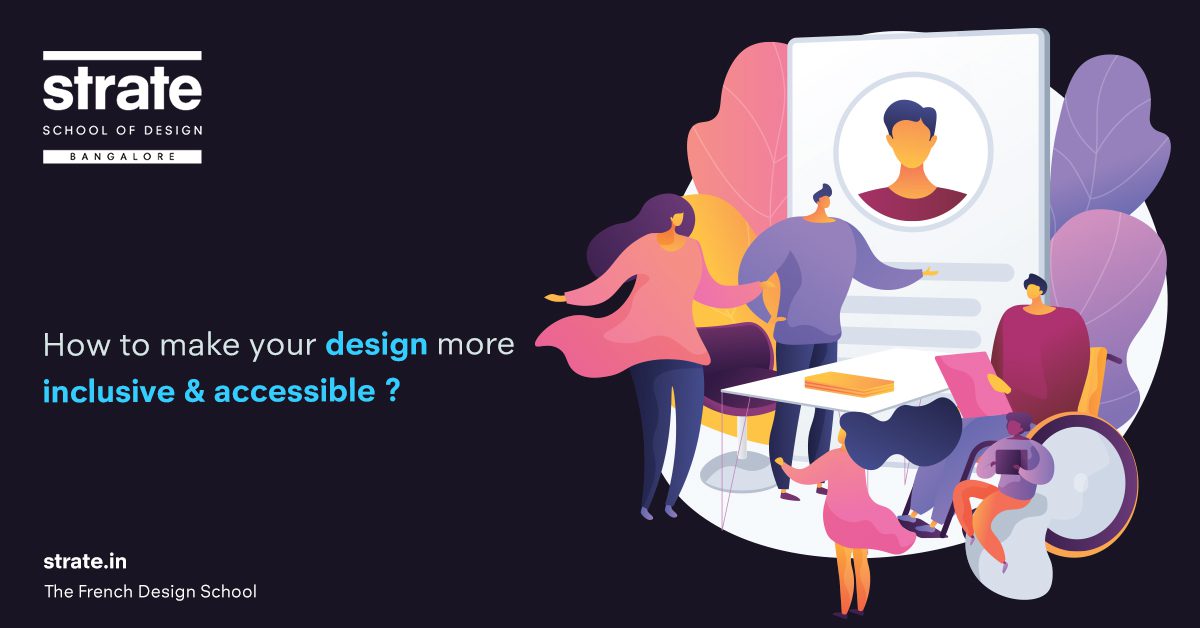As a brand or a designer, one should be looking to make their product more accessible and inclusive. We are living in a digitally connected and running world where digital solutions and products are more than ever needing to be more accessible and inclusive.
While accessibility is building for people who are differently abled, inclusion is building for all. On a straight line, if a simple design idea is the starting point, then accessibility is step further ahead of it and another step further of it is inclusivity. Each point is equally important to consider during a robust and inclusive product development process. Design teams today have many design based R&D tools to identify, measure and cover the gaps in this line, while involving many others as co-creators of the solution.
Why?
From an ethics perspective, this is a proper thing to do. We should aim at enabling everyone equally in the products and experiences we build. As a brand – this helps users to understand you care for all and their success. It also helps drive innovation, building solutions with longevity and offering aid to the people who need it.
Globally, countries have their own laws to protect people living with disabilities. This involves offering them equal access to work opportunities, life choices, government based programs and services and more.
First step for you as a brand or an organization is to understand where you are on the straight line or in other words, the spectrum – this helps to know where to start from. If you include accessibility and inclusion from the beginning of your design process, this is most effective and impactful. However, for many products that already exist, brands can find reasonable points of change.
Read more: How skilled experienced designers are the backbone of start-ups?
Design for Accessibility and Inclusivity
When designing for differently abled people, many countries and global organizations have guidelines, legal requirements and more that are well-defined and are not changing often. This can act as a step one to apply accessibility standards for your product design process.
On the other hand, inclusivity is a daunting task. It is after all design for all. While it is aspirational and almost a never-ending path, the pursuit of this is proven to be worthwhile and perhaps necessary for the world we live in today.
Here are a few steps one can take weather you design for accessibility and inclusivity from start or want to include it in an existing product:
1. Lead by example:
Advocate for accessibility and build empathy:
If your design process is only on step one, that is the left side of the spectrum, then your first step is to advocate for prioritizing accessibility. Leadership in the UX/UI, product and engineering are key departments to bring this in. A passionate individual or a group of passionate designers can help bring in the organization change and educate others on the importance of designing for people with different abilities. Build your case with – why is it important to offer facts on the users of the products.
Microsoft and Google are great examples of building all inclusive product ranges.
As a designer you can ensure your code is accessible and share the best practices with peers.
Read more: How to get your children ready for design studies?
For inclusivity, you must identify further the underserved users.
These unique user groups may be people, for example, who do not follow gender norms. This calls for different features, functionality and other considerations. Identifying key underserved users/ groups relevant to your product should be your starting point. Here the idea of ‘Design with, not for’ is the ideal way forward. Involving users you are designing for will give you crucial insights for product development.
Read more: Design tools for metaverse
2. Accessibility and Inclusivity review
If you are unsure that your product is accessible for all, then there are many useful links one can find online that can help you gain an understanding of whether the product is accessible or not. There are essentially two ways to help get your existing product to be more accessible and inclusive:
Phased out approach– This is a phase wise approach to tackle each step in a timely fashion. You can prioritize steps crucial to be done first – divide them into various timeline based projects for the team.
All at once/ One fell swoop – This is when you pause other projects and make this your number one priority in the design process. This is one of the fastest ways to make a product accessible and inclusive.
A fine example is the first typewriter for blind people was in the 1800s. Inclusivity design also pushes designers to leaps in innovation and enhanced solutions for users.
3. Training the team
We all know how crucial education and training are in our overall development, in this case, they are crucial for product success too. Your team should be familiar with the accessibility requirement, underserved user groups to encourage inclusivity, user experiences, their emotions involved and their basic requirements. This is a one time investment in the team’s growth and helps to increase your overall product value.
Google is known to offer some great resources on designing for accessibility.
Read more: How to get your children ready for design studies?
4. Maintain the accessibility in design
Once your team is trained, the product is accessible, it is now an ongoing effort and planning to maintain accessibility when new product developments happen, from a brand new design to improvements in feature and functionality – everything will involve designing for accessibility as well. Establishing a repeatable process for design ideation, building and testing will go a long way. After all, this is also designing with a humanity centric approach.
Taking up both accessibility and inclusion at the same time might be a daunting task for many, for this reason, experts have also found that brands can start with accessibility first and then take up inclusivity when their process of accessibility is intact and proven to succeed. Offering alternatives to a product or solution is better than separate experiences for differently abled people or different user groups. Designers should consider here multiple modes of inputs, customizations and adaptation to the product.
In conclusion, the journey of a brand or a designer towards an all inclusive product and towards the right end of the spectrum does not need to be all-encompassing. Start with what you can, where you can and build a phased out approach, most important stay consistent in your path. Research and development are key to your success.
Also read: Designing for emotions and mindsets






Want to Become a Designer ?
Strate is a unique design school that nurtures your talents as a designer by offering state-of-the art designing courses in Bangalore.
Join Strate